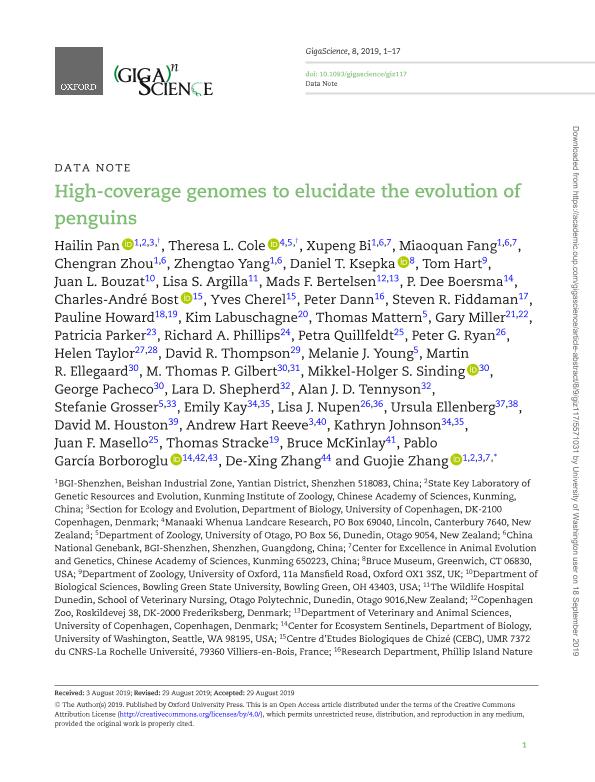Artículo
High-coverage genomes to elucidate the evolution of penguins
Pan, Hailin; Cole, Theresa L; Bi, Xupeng; Fang, Miaoquan; Zhou, Chengran; Yang, Zhengtao; Ksepka, Daniel T; Hart, Tom; Bouzat, Juan L.; Boersma, P. Dee; Bost, Charles-André; Cherel, Yves; Dann, Peter; Mattern, Thomas; Ellenberg, Ursula; Garcia Borboroglu, Jorge Pablo ; Argilla, Lisa S.; Bertelsen, Mads F.; Fiddaman, Steven R.; Howard, Pauline; Labuschagne, Kim; Miller, Gary; Parker, Patricia; Phillips, Richard A.; Quillfeldt, Petra; Ryan, Peter G.; Taylor, Helen; Zhang, De-Xing; Zhang, Guojie; McKinlay, Bruce
; Argilla, Lisa S.; Bertelsen, Mads F.; Fiddaman, Steven R.; Howard, Pauline; Labuschagne, Kim; Miller, Gary; Parker, Patricia; Phillips, Richard A.; Quillfeldt, Petra; Ryan, Peter G.; Taylor, Helen; Zhang, De-Xing; Zhang, Guojie; McKinlay, Bruce
 ; Argilla, Lisa S.; Bertelsen, Mads F.; Fiddaman, Steven R.; Howard, Pauline; Labuschagne, Kim; Miller, Gary; Parker, Patricia; Phillips, Richard A.; Quillfeldt, Petra; Ryan, Peter G.; Taylor, Helen; Zhang, De-Xing; Zhang, Guojie; McKinlay, Bruce
; Argilla, Lisa S.; Bertelsen, Mads F.; Fiddaman, Steven R.; Howard, Pauline; Labuschagne, Kim; Miller, Gary; Parker, Patricia; Phillips, Richard A.; Quillfeldt, Petra; Ryan, Peter G.; Taylor, Helen; Zhang, De-Xing; Zhang, Guojie; McKinlay, Bruce
Fecha de publicación:
09/2019
Editorial:
Oxford University Press
Revista:
GigaScience
e-ISSN:
2047-217X
Idioma:
Inglés
Tipo de recurso:
Artículo publicado
Clasificación temática:
Resumen
Background: Penguins (Sphenisciformes) are a remarkable order of flightless wing-propelled diving seabirds distributed widely across the southern hemisphere. They share a volant common ancestor with Procellariiformes close to the Cretaceous-Paleogene boundary (66 million years ago) and subsequently lost the ability to fly but enhanced their diving capabilities. With ∼20 species among 6 genera, penguins range from the tropical Galápagos Islands to the oceanic temperate forests of New Zealand, the rocky coastlines of the sub-Antarctic islands, and the sea ice around Antarctica. To inhabit such diverse and extreme environments, penguins evolved many physiological and morphological adaptations. However, they are also highly sensitive to climate change. Therefore, penguins provide an exciting target system for understanding the evolutionary processes of speciation, adaptation, and demography. Genomic data are an emerging resource for addressing questions about such processes. Results: Here we present a novel dataset of 19 high-coverage genomes that, together with 2 previously published genomes, encompass all extant penguin species. We also present a well-supported phylogeny to clarify the relationships among penguins. In contrast to recent studies, our results demonstrate that the genus Aptenodytes is basal and sister to all other extant penguin genera, providing intriguing new insights into the adaptation of penguins to Antarctica. As such, our dataset provides a novel resource for understanding the evolutionary history of penguins as a clade, as well as the fine-scale relationships of individual penguin lineages. Against this background, we introduce a major consortium of international scientists dedicated to studying these genomes. Moreover, we highlight emerging issues regarding ensuring legal and respectful indigenous consultation, particularly for genomic data originating from New Zealand Taonga species. Conclusions: We believe that our dataset and project will be important for understanding evolution, increasing cultural heritage and guiding the conservation of this iconic southern hemisphere species assemblage.
Archivos asociados
Licencia
Identificadores
Colecciones
Articulos(CESIMAR)
Articulos de CENTRO PARA EL ESTUDIO DE SISTEMAS MARINOS
Articulos de CENTRO PARA EL ESTUDIO DE SISTEMAS MARINOS
Citación
Pan, Hailin; Cole, Theresa L; Bi, Xupeng; Fang, Miaoquan; Zhou, Chengran; et al.; High-coverage genomes to elucidate the evolution of penguins; Oxford University Press; GigaScience; 8; 9-2019; 1-17
Compartir
Altmétricas



